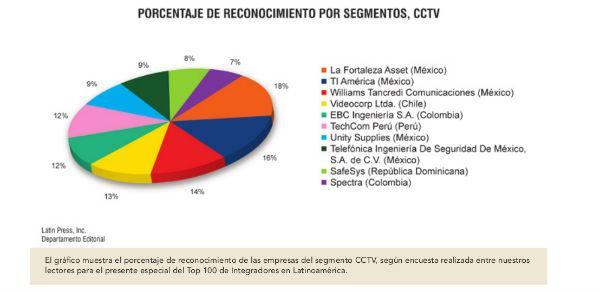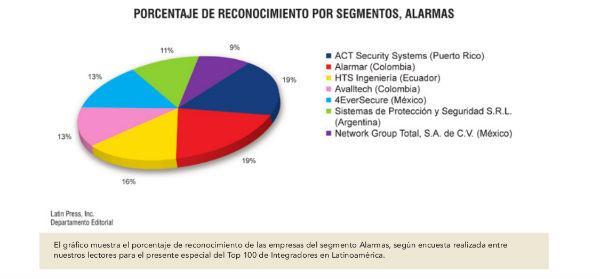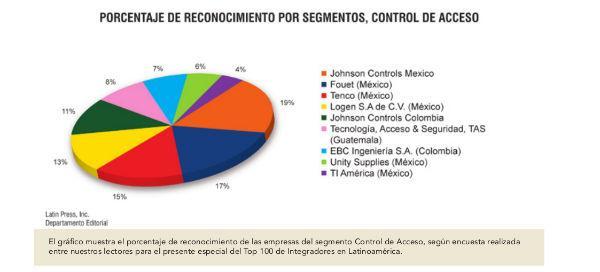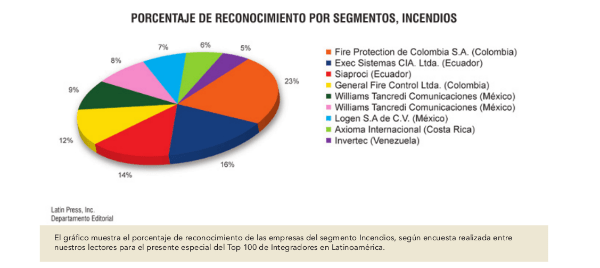The good climate that is lived in the region allows us to be optimistic and at the same time to be participants in a positive reality, one of those links in the chain that enjoys the current moment is precisely that of the integrators, who are first-line dynamizers in the business of electronic security.
by Santiago Jaramillo Hincapié
It is undeniable that the current moment that the Latin American region is experiencing compared to that of other latitudes has made the interest of many segments look focused on this part of the world, especially if we talk about electronic security, an area that has been dynamized with special value.
The peaks of this industry have been high at times, others were characterized by being forced labor to maintain, but the really significant thing is that it has known how to take advantage of each juncture to strengthen itself and, for now, come out ahead.
For this reason, and seeking to elucidate the current moment and what is coming, we wanted to bring you a special in which we look at the economic prospects of the region, of the different segments of the electronic security industry, as well as of an important link in this chain, the Latin American integrators.
In the same way in this edition we include the first Top 100 of most outstanding Integrators in Latin America, a complete ranking in which the work and recognition of these members of the industry is highlighted.
Dynamizers of a prosperous future
Precisely some frontline actors in this value chain have definitely been the integrators, those haughty actors that in an even-handed way set the tone, creating value for the industry and forging a prosperous future in the region.
Latin American integrators have evolved thanks to the fact that they have understood that today their clients need more transversal and complete solutions, which allow them to manage their business information in the clearest, fastest and most secure way possible. In this process, the role and transformation of integrators have been key.
It is worth saying that they have become professionalized, have more methodologies and tools tested and standardized internationally to guarantee the success of the projects they lead. This is in response to the fact that customers are better prepared to tackle initiatives that allow them to improve their efficiency and productivity indicators in the facilities.
The meaning of the role of a technology integrator, especially in the field of electronic security, be it CCTV, access control, alarms, perimeter, fires, etc., has a lot to do with understanding the customer's need and being able to offer a solution of high added value. This, according to Juan Eduardo Quivera, Commercial Director of the company Integ Solutions, allows us to look at the market with total objectivity, strictly looking for the best for that client in order to integrate it into a global project.
Although Carlos Tirado, Senior Manager of the company Access Control, warns that although it may seem like a catchphrase, customers pose a problem and integrators are responsible for giving the best solution, uniting different brands, technologies, platforms, equipment and even other suppliers. "The important thing is not to lose sight of the need to deliver greater added value at the best cost under quality and efficiency parameters," he says.

But there's more. Federico Silva, Director of Electronics GSE, points out that in addition to generating the best technological solution to the project, it is necessary to see how it impacts and generates value. That is why knowledge in consulting is necessary, which is added to the implementation of technologies and equipment, resulting in integration.
Precisely the main point in which the integrator adds value is when he manages to make a technology work, but also coexists successfully with the other solutions that coexist in the security installation.
But, in what way is an integrator able to achieve these objectives?, the answer is clear: thanks to its expert knowledge of both technology and equipment and the market, the environment of the installation and that it is located several steps above the simple sale. The security integrator requires certain skills and knowledge, which even manufacturers and distributors do not have, because they focus their work on the attributes of a certain platform or product, without the vision of integrating them and making them work in the best possible way in multiple environments.

In this process, many integrators decided to become strategic partners of their customers; something that is in the subconscious of almost everyone who is part of the technology integration market. Everyone wants to be an important piece in the operational gear of their customers and the market is accepting that proposition. "This is a pleasant transformation. We are no longer a simple supplier and coordinator of different technologies, but we become a partner to which the company asks for help to grow, develop its projects, and make an assertive key to success, "says Silva.
It is well known that most of the electronic security equipment used in the Latin American region is imported. Similarly, there are a wide range of companies dedicated to the distribution, integration and installation of systems, as well as the provision of the corresponding services.
Products and services related to electronic security are enjoying excellent growth in the regional market. The trend, which can be summarized in a basic chain of import, distribution, installation and maintenance support, has been behaving in a special way, and obtaining very good, if not excellent returns.

The demand for security systems and devices is growing in Latin America largely due to the investment in infrastructure that most countries in the area have been having, and in contrast to this, due to the high rates of violence and insecurity that occurs in them.
It is worth noting that Closed Circuit Television (CCTV), also known as video surveillance, are the technological equipment of greater demand in the region, followed, with a considerable light of advantage by access control systems, alarms and fire detection.
In the access control segment, the market increasingly demands systems that provide an integral solution to the different problems and needs that are presented to the user. Simply put, a tailor-made solution. Every day it is more important, due to the already exposed continuous insecurity, which has forced everyone, large and small businesses, to make investments in electronic security and, in particular, in access controls, all in order to control employees, users, etc., or in order to prevent an illicit act through this type of products.
 In the case of the fire segment, one of the greatest difficulties that arise is definitely the lack of a more demanding regulation by the authorities of each country in the Latin American region, a situation that is needed to achieve a greater use of fire systems in buildings in the region.
In the case of the fire segment, one of the greatest difficulties that arise is definitely the lack of a more demanding regulation by the authorities of each country in the Latin American region, a situation that is needed to achieve a greater use of fire systems in buildings in the region.
On the other hand, with regard to the segment of alarm systems, as already indicated by SECURITY SALES, these are taking more and more strength in the region, thanks to the good health experienced by the Latin American security industry, also the sector that is contributing the most in this growth is mainly that of private security companies (Electronics and physical), which account for about 70% of the market. Another 20% is required by corporations or companies that decide to form their own monitoring centers to control their dependencies, branches and warehouses. Another 5% of the market is reserved for financial and banking entities, and the final 5% is oriented to the residential sector, which provides electronic security not only to homes but also to the outer perimeter.
Regions: uneven but firm development
The optimal economic situation experienced by countries in the region such as Chile, Peru and Colombia, the income and investments that tourists will bring to Brazil and neighboring countries for the World Cup and the 2016 Olympics; the possibility of continuing to grow steadily for the next five years and even the eventuality that markets such as Bolivia, Paraguay and Uruguay manage to mark unexpected businesses make up some of the reasons why it is prudent to affirm that the region is more attractive than ever for investors.
According to information presented by the Getulio Vargas Foundation, the business climate in Latin America rose in January to the best level since April last year. The conclusion came from the Economic Climate Index (ECI) for Latin America, a measurement that is made in conjunction with the Institute for Economic Studies (IFO) of the University of Munich after making quarterly consultations with 141 specialists from 18 countries.
For its part, the International Monetary Fund (IMF) predicted a hectic 2014 for the Latin American economy where "more financial turbulence", a "moderation" in commodity prices and a "rebalancing" of the economy of China, the region's main trading partner in the last decade, will be combined.
The economy of Latin America as a whole will rebound from 2.6% growth in 2013 to 3% in 2014, although for this year the IMF forecasts an uneven behavior depending on the countries.
Mexico and the economies of Central America and the Caribbean, strongly linked to the United States, will see a rebound due to the good momentum of the world's leading economy, said Alejandro Werner, director of the Western Hemisphere of the Fund at a press conference.
In the lead, Mexico, for which growth of 3% is expected in 2014, more than double that registered in 2013, thanks to the rebound in domestic demand and the effects of the first reforms announced by the new government of President Enrique Peña Nieto.
Likewise, in Central America, the increase in global demand will boost tourism and exports, and construction activity in the United States will stimulate remittances, which already grew at a year-on-year rate of 6.5% in the third quarter of 2013.
For its part, in South America the situation is drawn in a more varied way, mainly as a result of the slowdown in China, the withdrawal of monetary stimulus in the US and the moderation of commodity prices. In this area, Werner established two groups of countries for which he drew different scenarios.
He stated that, on the one hand, "the large exporting countries of financially open raw materials (Brazil, Chile, Colombia, Peru and Uruguay)", will register an average growth slightly below 4%.
With Brazil at the tail end of the group, as it foresees growth still restricted by the lack of investment, which will be 2.3% in 2014, practically unchanged compared to 2013. On the other, it places Argentina and Venezuela, which face a "less favorable" outlook due to the pressures "on inflation, the balance of payments and the exchange markets" that have been suffering in recent months.
Argentina, precisely, has been one of the emerging markets that has had to intervene in its currency in the face of the financial volatility registered and the anticipation that the progressive withdrawal of monetary stimulus by the US Federal Reserve (Fed) could deepen the loss of value of its currency.
In addition, these financial tensions have spread fears of contagion to Argentina's traditional trading partners such as Brazil or Uruguay.
However, Werner stressed that these economies are in a much more "solid" position than "two decades" ago, so he lowered the risks, although he urged to remain alert.
In the case of Venezuela, the IMF official said that "the loss of (international) reserves that had been occurring in 2013 puts this economy in a delicate situation" and stressed that "over the past year we have seen a very significant slowdown in economic growth."

























Leave your comment